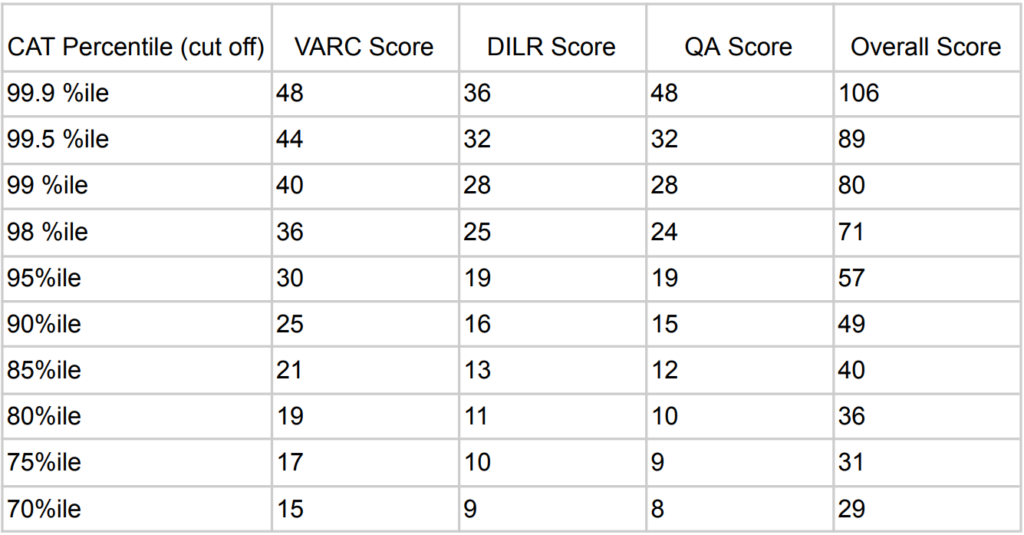CAT Cut Off
The Common Admission Test (CAT) is one of the most prestigious entrance exams foradmission into top MBA colleges in India, particularly the Indian Institutes of Management (IIMs). The cutoff refers to the minimum percentile required for eligibility to be shortlisted for further rounds of the admission process, which generally includes Group Discussions (GD), Personal Interviews (PI), and Written Ability Tests (WAT). Here’s a detailed overview of CAT cutoffs, including factors that influence them, the difference between qualifying and final cutoffs, as well as expected cutoffs for the 2024 exam cycle.
Factors Determining CAT Cutoff
- Difficulty Level of the Exam: If the exam is particularly difficult, the cutoff may be lower as fewer candidates score higher. Conversely, in easier years, the cutoff may rise as more candidates score high marks.
- Number of Candidates Appearing: If the number of candidates is higher, the cutoffs for top institutions may go up. On the other hand, a decrease in the number of candidates may result in slightly lower cutoffs.
- Number of Seats Available: Colleges with a larger intake of students may have relatively lower cutoffs compared to institutions with fewer seats, as they need to balance demand and supply.
- Performance in Different Sections: In many colleges, there may be a sectional cutoff in addition to an overall cutoff. This means candidates need to score a minimum percentile in each section (Quantitative Ability, Data Interpretation & Logical Reasoning, Verbal Ability & Reading Comprehension) to be eligible for shortlisting.
- Reservation Policies: Some IIMs and other top colleges offer relaxation of cutoff for candidates from reserved categories (e.g., SC, ST, OBC, PwD).
Types of CAT Cutoffs
- Qualifying Cutoff: This is the minimum percentile required to be eligible for shortlisting for the next stage of the selection process (e.g., GD/PI). Meeting this cutoff doesn’t guarantee admission but is required to advance further in the process.
- Final Cutoff: After the interview process and final selection, the final cutoff is the
percentile that candidates must achieve to secure admission to the institute. This cutoff varies every year based on the overall performance of candidates, the number of seats, and the selection process.
CAT 2024 Expected Cutoffs for Different Categories
The expected CAT 2024 cutoffs for various IIMs and MBA colleges are expected to remain similar to previous years. Here’s an estimated range:
Top IIMs (IIM Ahmedabad, IIM Bangalore, IIM Calcutta, IIM Lucknow, IIM Kozhikode)- IIM Ahmedabad: 99+ percentile (General category)
- IIM Bangalore: 99+ percentile
- IIM Calcutta: 99+ percentile
- IIM Lucknow: 98-99 percentile
- IIM Kozhikode: 98-99 percentile
These top-tier IIMs generally have the highest cutoffs, and only those with exceptionally high
scores are able to secure a spot.
Tier 2 MBA Colleges
● Expected Cutoff: 70-80 percentile and above
● Examples of Tier 2 colleges may include SP Jain Institute of Management &
Research (SPJIMR), Xavier Labour Relations Institute (XLRI), Institute of
Management Technology (IMT), and Management Development Institute (MDI).
These colleges maintain a high standard of education but have slightly lower cutoffs compared
to the top IIMs.
Tier 3 MBA Colleges
● Expected Cutoff: 60-70 percentile and above
● Examples may include colleges like Symbiosis Institute of Business Management
(SIBM), KJ Somaiya Institute of Management, and Tata Institute of Social Sciences
(TISS).
These colleges have a more accessible cutoff range and often offer specialized MBA programs.Previous Year’s CAT Cutoffs
Here’s a quick glance at the cutoffs of some top IIMs from previous years to give you an idea of
how they have been trending:
Institute General Category Cutoff (Percentile)
IIM Ahmedabad 99.5+
IIM Bangalore 99+
IIM Calcutta 99+
IIM Lucknow 98-99
IIM Kozhikode 98-99
SPJIMR 94-96
XLRi 93-95
Conclusion
The CAT exam is highly competitive, and the cutoff scores depend on various factors, including the difficulty of the exam, the number of candidates, and the selection process of each institute. While top IIMs typically have cutoffs of 99+ percentile, Tier 2 and Tier 3 colleges have
comparatively lower cutoffs, which provides opportunities for candidates with diverse score ranges. CAT 2024 cutoffs are expected to follow a similar trend, but candidates should keep an eye on the official announcements by each institution for precise details.

Here is the summary of the CAT 2024 Results based on percentiles:
- 1. 100 Percentiles (14 Toppers)
- Gender Breakdown:
○ Female: 1
○ Male: 13
Discipline:
○ Engineering: 13
○ Non-Engineering: 1
State Breakdown:
○ Andhra Pradesh: 1
○ Delhi: 2
○ Haryana: 1
○ Kerala: 1
○ Maharashtra: 5
○ Odisha: 1
○ Rajasthan: 1
○ Telangana: 2 - 2. 99.99 Percentiles (29 Toppers)
Gender Breakdown:
○ Female: 2
○ Male: 27
Discipline:
○ Engineering: 25
○ Non-Engineering: 4
State Breakdown:
○ Chandigarh: 1
○ Delhi: 4
○ Gujarat: 2
○ Haryana: 1
○ Karnataka: 3
○ Kerala: 1
○ Madhya Pradesh: 1
○ Maharashtra: 5
○ Odisha: 1
○ Punjab: 1
○ Rajasthan: 3
○ Tamil Nadu: 1
○ Telangana: 1
○ Uttar Pradesh: 1
○ Uttarakhand: 1
○ West Bengal: 2 - 3. 99.98 Percentiles (30 Toppers)
Gender Breakdown:
○ Female: 1
○ Male: 29
Discipline:
○ Engineering: 20
○ Non-Engineering: 10
State Breakdown:
○ Bihar: 1
○ Delhi: 2
○ Gujarat: 2
○ Haryana: 4
○ Karnataka: 4
○ Madhya Pradesh: 3
○ Maharashtra: 3
○ Tamil Nadu: 2
○ Telangana: 3
○ Uttar Pradesh: 2
○ West Bengal: 4.
1. Understand the Exam Pattern and Syllabus
● Exam Details: The CAT exam is a Computer-Based Test (CBT) conducted by IIMs. It consists of 66 questions, with a duration of 120 minutes.
● Syllabus: The exam includes three sections:
○ Verbal Ability and Reading Comprehension (VARC)
○ Data Interpretation and Logical Reasoning (DILR)
○ Quantitative Ability (QA)
● Study Resources: Collect study material from reliable sources. It’s better to focus on a few good quality books and revise them thoroughly rather than using too many resources.
2. Practice with Mock Papers and Previous Year Papers
● Mock Tests: Take online mock exams regularly to simulate the actual exam environment. Mock tests are crucial for improving speed, accuracy, and time management.
● Past Papers: Solve previous year’s CAT papers to understand the exam pattern, types of questions, and difficulty level.
● Analyze Mock Tests: After taking mock tests, carefully analyze your performance. Identify areas where you made mistakes and work on them.
3. Create a Study Plan and Stick to It
● Personalized Study Routine: Create a realistic and personalized study plan that works for your strengths and weaknesses. Dedicate more time to areas you find difficult.
● Consistency: Follow your study plan consistently. Make adjustments if needed, but avoid procrastination. Track your progress regularly.
● Balanced Approach: Set aside time for regular revision and practice. Stick to your schedule to maintain discipline.
4. Prepare with Mock Exams
● Online Mock Tests: Make use of online test series and sample exams to enhance your preparation. These will provide you with detailed feedback, helping you track your progress.
● Focus on Weak Areas: Use mock exams to pinpoint areas that need improvement. Work on your weak spots to enhance your overall performance.
5. Avoid Common Mistakes
● Neglecting Weak Areas: Don’t ignore areas where you struggle. Devote extra time to these sections and practice more to improve.
● Ignoring Doubts: Always clarify doubts as soon as possible. Avoid leaving them unresolved, as they can affect your understanding of key concepts.
● Poor Time Management: Inadequate time management can lead to incomplete papers. Practice solving questions within a time limit to improve your speed.
6. Incorporate Effective Study Tactics
● Time Management: Manage your time wisely during the exam. Practice answering questions quickly and efficiently.
● Trick and Shortcuts: Learn shortcuts to solve problems faster, especially in Quantitative Ability and Logical Reasoning sections.
● Choose the Right Questions: Focus on questions you can solve confidently. Don’t waste time on difficult questions. Prioritize easier questions to maximize your score.
7. Improve Vocabulary
● Reading Practice: Regularly read newspapers, books, editorials, and journals to enhance your vocabulary, which will help in the Verbal Ability section.
● Word Lists: Maintain a list of new words you come across and try to use them in your daily conversations.
8. Revise Regularly
● Scheduled Revision: Include regular revision sessions in your study plan. Revising concepts will help you retain information and improve recall on exam day.
● Use Notes: Make concise notes while studying and review them regularly to reinforce key concepts.
9. Stay Disciplined and Focused
● Dedicated Study Time: Establish a dedicated study time, either early in the morning or late at night, based on when you are most productive.
● Cut Down Distractions: Limit distractions during study sessions by turning off notifications and setting boundaries with others.
● Stay Motivated: Maintaining discipline and staying motivated throughout the preparation period is crucial for long-term success.
10. Be Prepared for the Exam Day
● Application Form: Fill out the CAT application well in advance to avoid last-minute stress.
● Admit Card: Print your admit card early to avoid any issues on the exam day.
● Exam Strategy: On the day of the exam, remain calm and stick to your strategy. Prioritize easier questions and manage your time wisely
Conclusion:
Success in the CAT exam is achievable with dedication, discipline, and a strategic approach. By following a structured study plan, practicing regularly with mock tests and previous year papers, and addressing weak areas, you can improve your chances of scoring well. Stay focused, stay motivated, and keep refining your strategy as you progress through your preparation. With consistent effort and determination, you can crack the CAT exam from the comfort of your home.
Free CAT mock tests are a highly effective way to enhance your preparation for the CAT exam and improve your chances of acing it. Here’s a breakdown of how these mock tests can help you succeed:
1. Benchmark Your Current Performance
Starting with a mock test at the beginning of your preparation helps you gauge where you stand. You get a clear idea of your strengths and weaknesses, which allows you to tailor your study plan accordingly. Understanding your starting point is crucial in setting realistic goals for your CAT journey.
2. Familiarize Yourself with the Exam Pattern
CAT is a standardized exam with a specific pattern that changes slightly each year. By taking free mock tests, you become familiar with the types of questions, the time limits, and the overall structure of the exam. This preparation allows you to adjust to the exam format and reduces anxiety on the actual test day.
3. Evaluate and Adapt Your Study Strategy
Consistently attempting mock tests provides the opportunity to assess what strategies work best for you. You can experiment with different approaches to time management, question selection, and problem-solving. After each test, you can fine-tune your preparation strategy based on performance insights, optimizing your study routine as needed.
4. Identify Strong and Weak Areas
Analyzing your mock test results reveals your strongest areas as well as the subjects or topics that need more attention. By recognizing areas for improvement, you can prioritize focused study on specific topics to maximize your sectional scores. This will help you boost your overall performance on the exam.
5. Understand Your Percentile and Peer Comparison
CAT is a percentile-based exam, and free mock tests give you a good idea of where you stand in comparison to other aspirants. This insight into your percentile allows you to understand how competitive you are and where to direct your efforts to improve further.
How to Take Free CAT Mock Tests:
1. Access the Mock Tests: Visit the website offering free CAT mock tests and find the section dedicated to them.
2. Choose the Test Type: Select the mock test you want to take based on your level of preparation or the sections you want to focus on.
3. Understand the Test Format: Read the instructions about the test’s format, time limits, and any other guidelines.
4. Start the Test: Begin the mock test under real exam conditions, strictly adhering to the timer and environment.
5. Complete the Test: After finishing, submit your test and sign up (if you haven’t already) to review your results.
6. Analyze Your Performance: Carefully review your answers, understand mistakes, and use insights to improve your preparation for the next test. By taking these mock tests regularly, you’ll be able to track your progress, adjust your study plan, and boost your confidence. Using these free resources, you can enhance your readiness and increase your chances of performing well on the CAT exam.

































